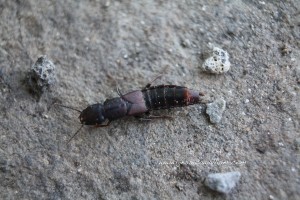This interesting little guy is a member of the Rove beetle family (Staphylinidae). Though at first glance, he might look like an earwig, the two come from entirely different insect orders and are not related. The lack of cerci (enlarged, forecep-like pincers) on his hind-end is one easy way to tell the difference between an earwig and a rove beetle. The rove beetle family has the honor of being one of the largest family of beetles in North America with over 3,000 species.Worldwide, there are nearly 60,000 different species. A distinctive feature of most rove beetles are the short wing covers that leave their segmented abdomens exposed. When threatened, many species curl their abdomen upwards in a scorpion-like fashion. No need to worry, though, as these beetles have no stinger. They are generally brown to black in color and measure 0.08–0.78 in. (2–20 mm) in length, though some species can reach much larger. Rove beetles are very beneficial in the garden. They are predators of insects that feed on decaying organic matter (a handful of parasitic species exist as well). Rove beetles commonly consume bark beetles, slugs, snails, ants, termites, root maggots, and many other insects. Most often found in plant debris, in manure and compost piles, under stones and in woodlands, rove beetles are predaceous as both adults and larvae.. The fast-moving larvae feed on the same prey species by capturing them with sickle-shaped jaws.








